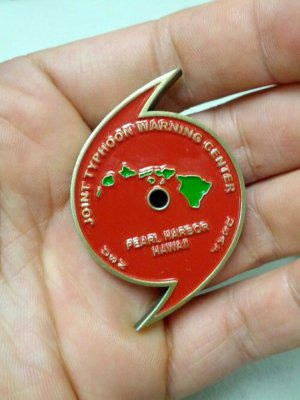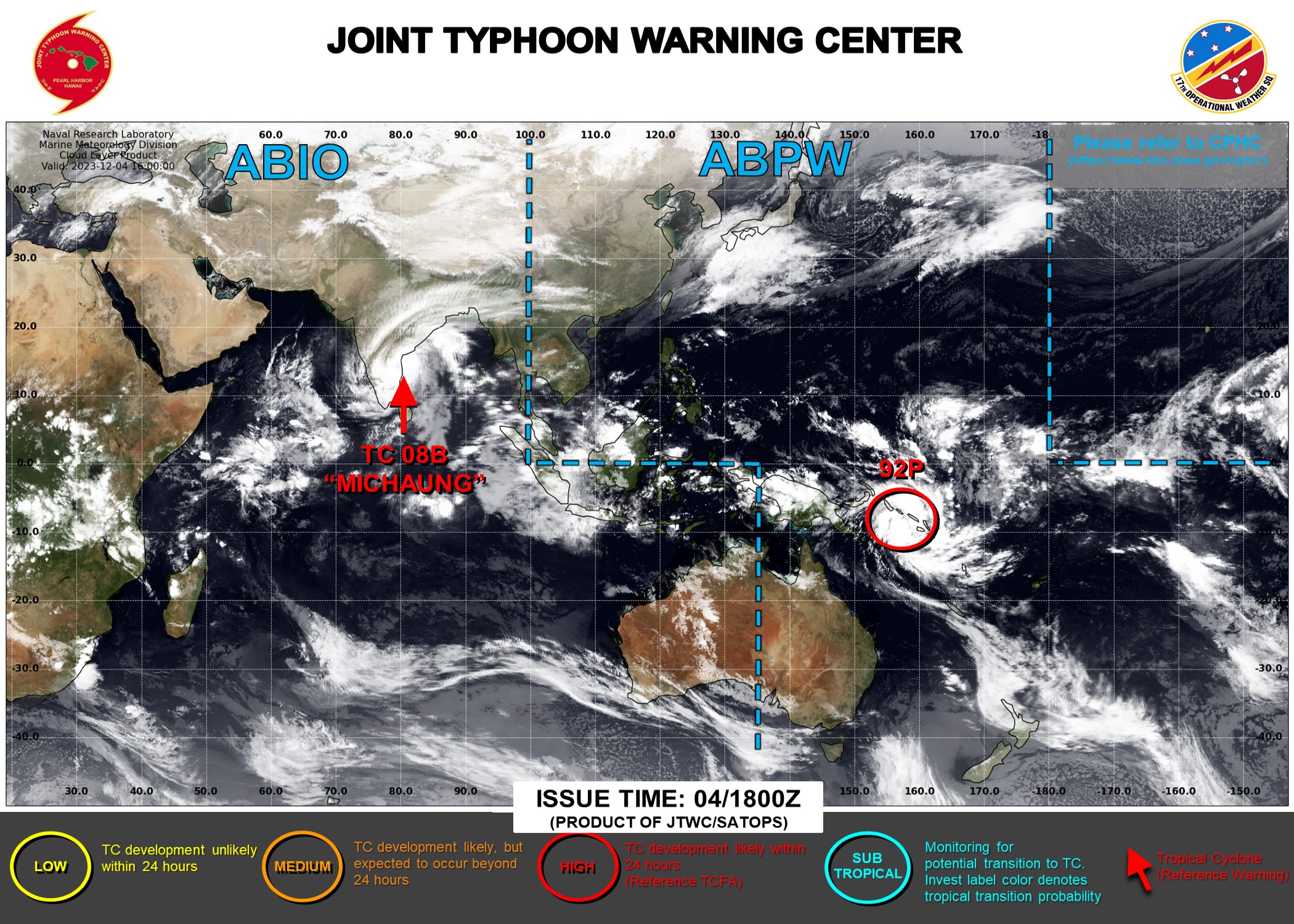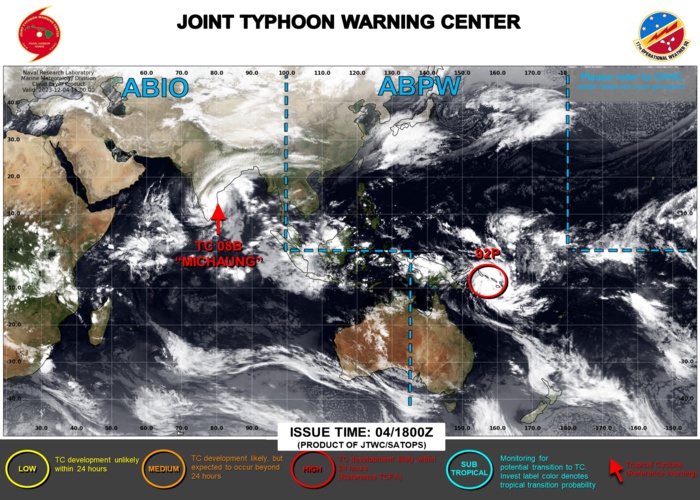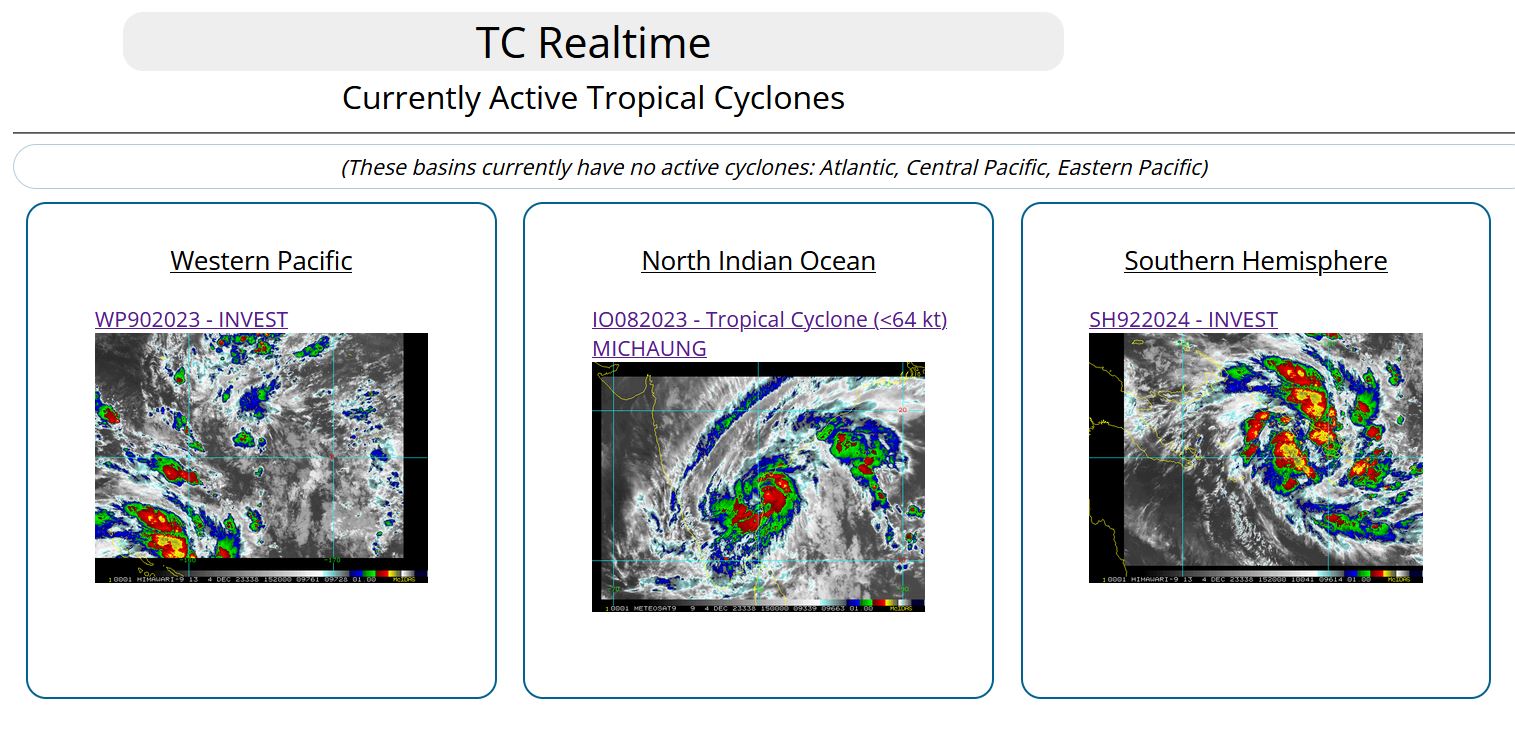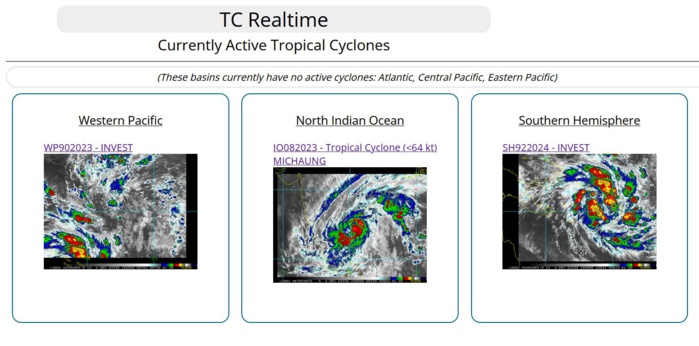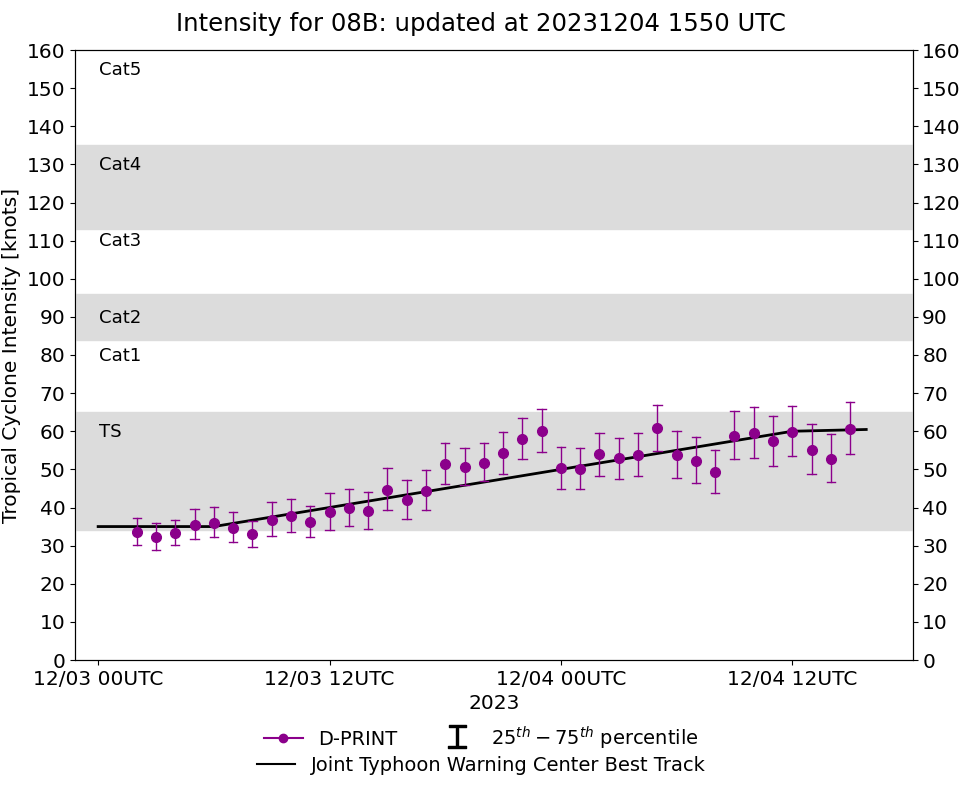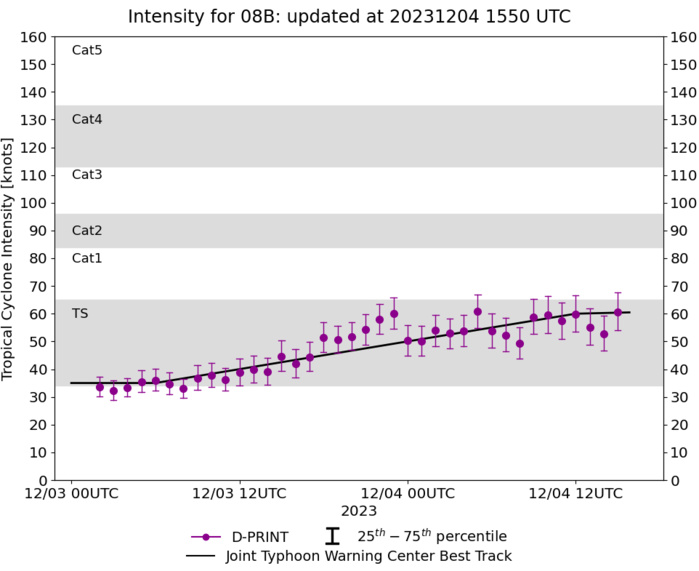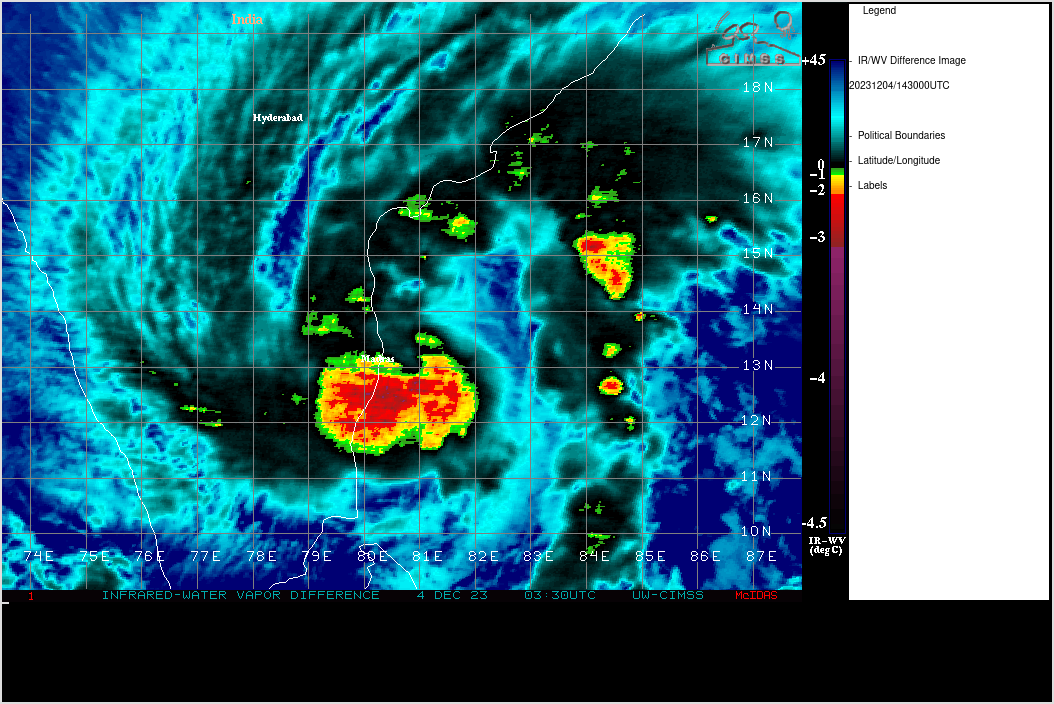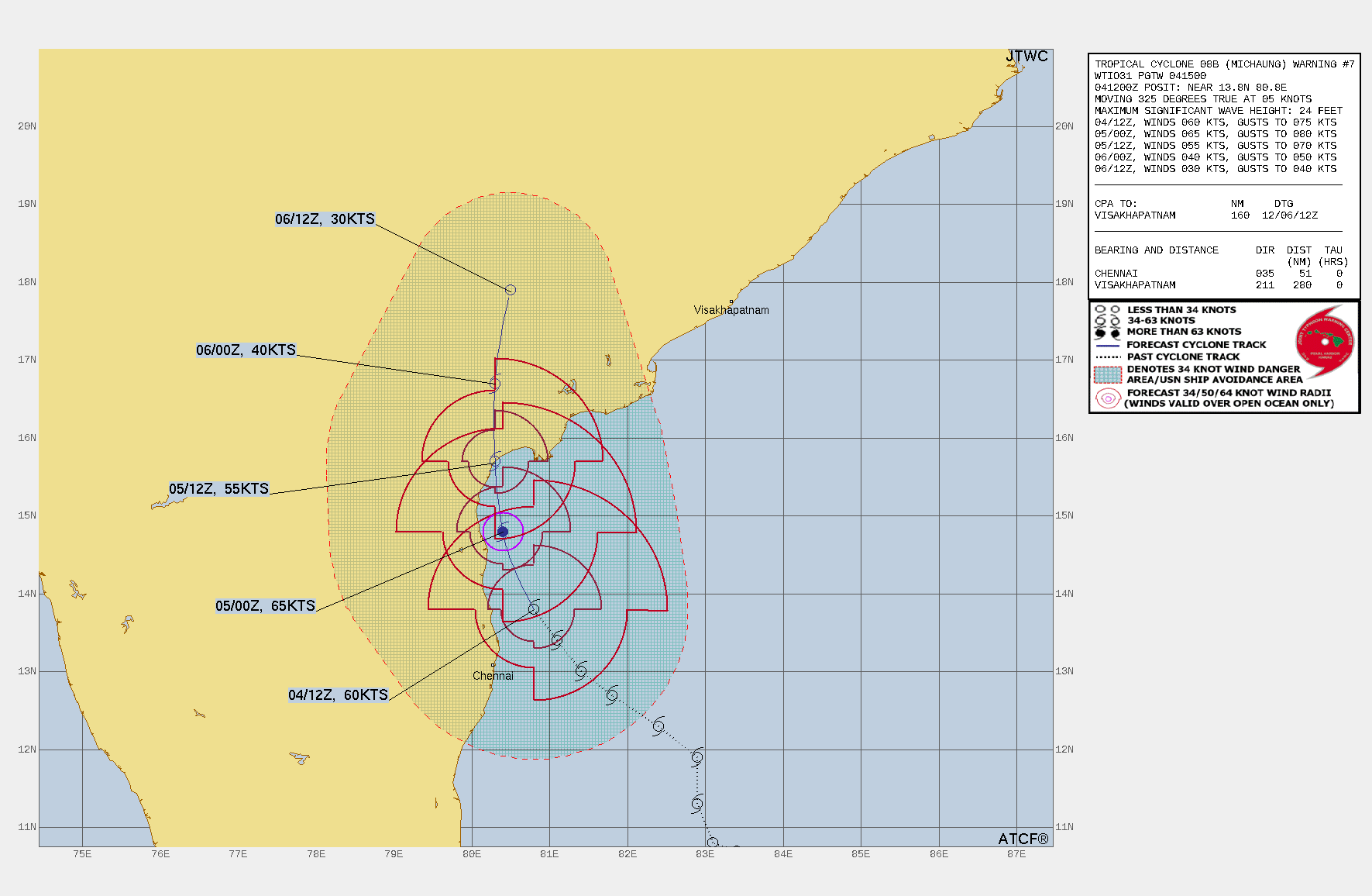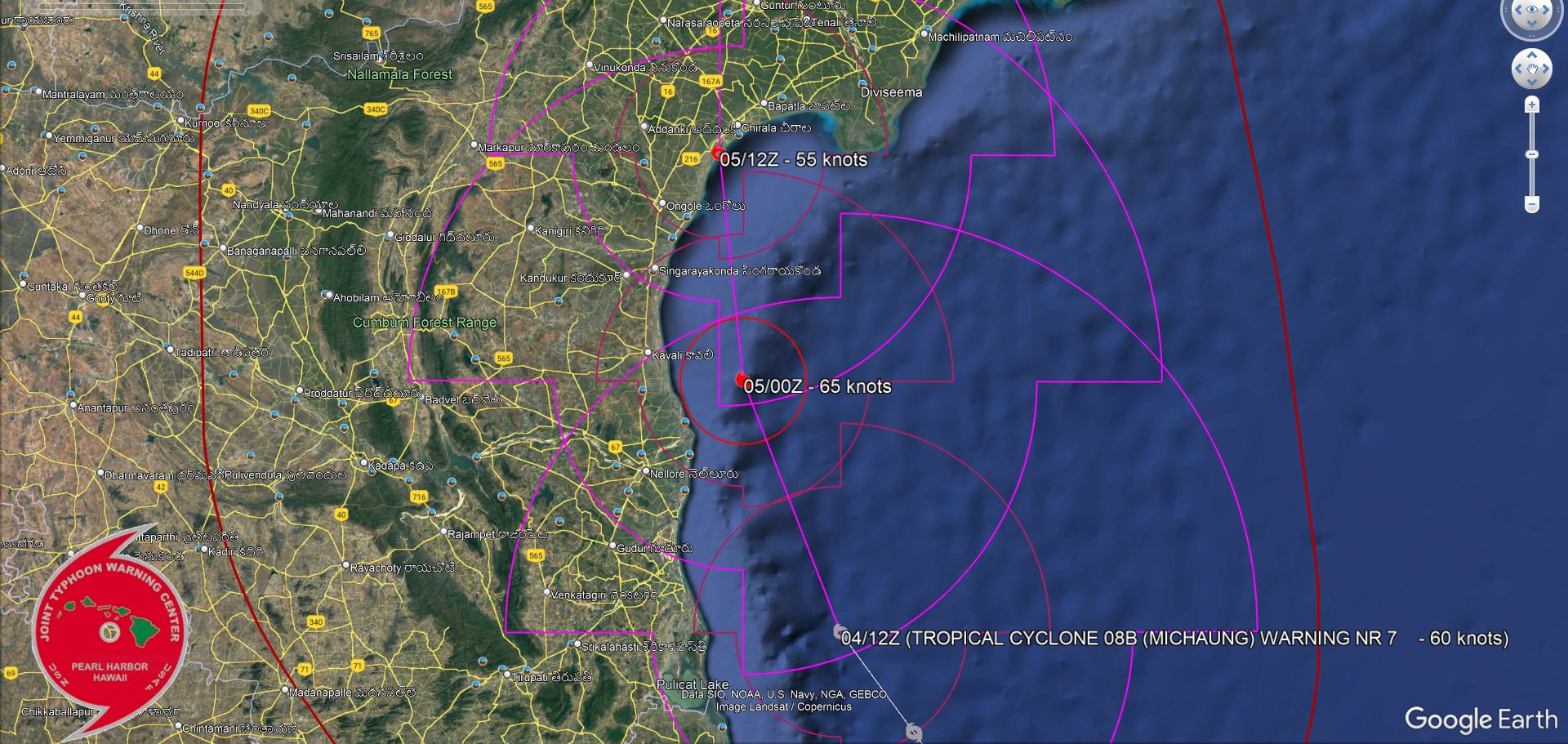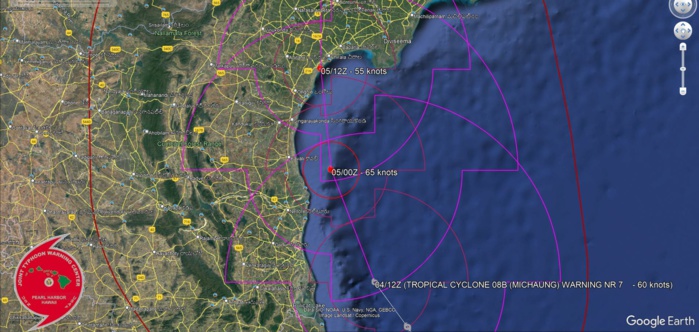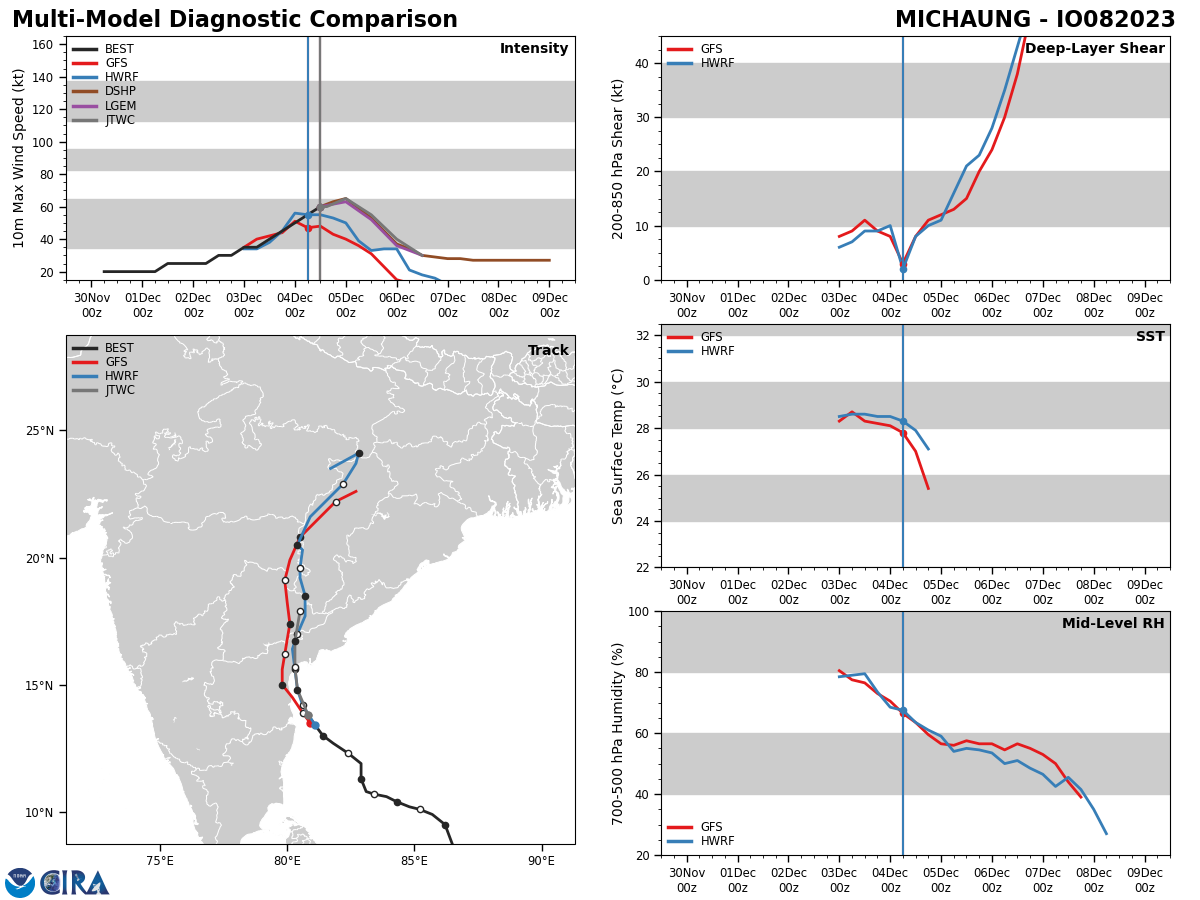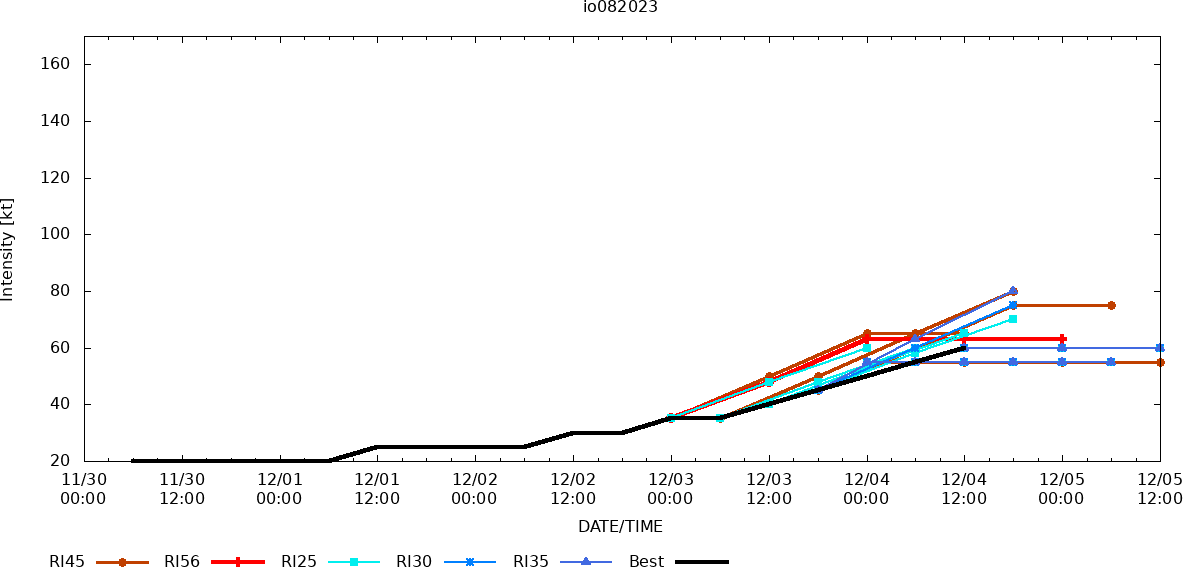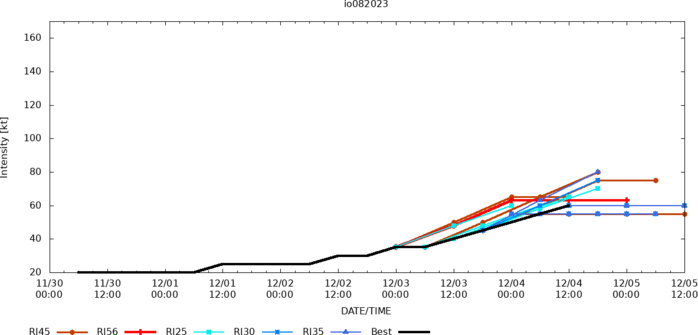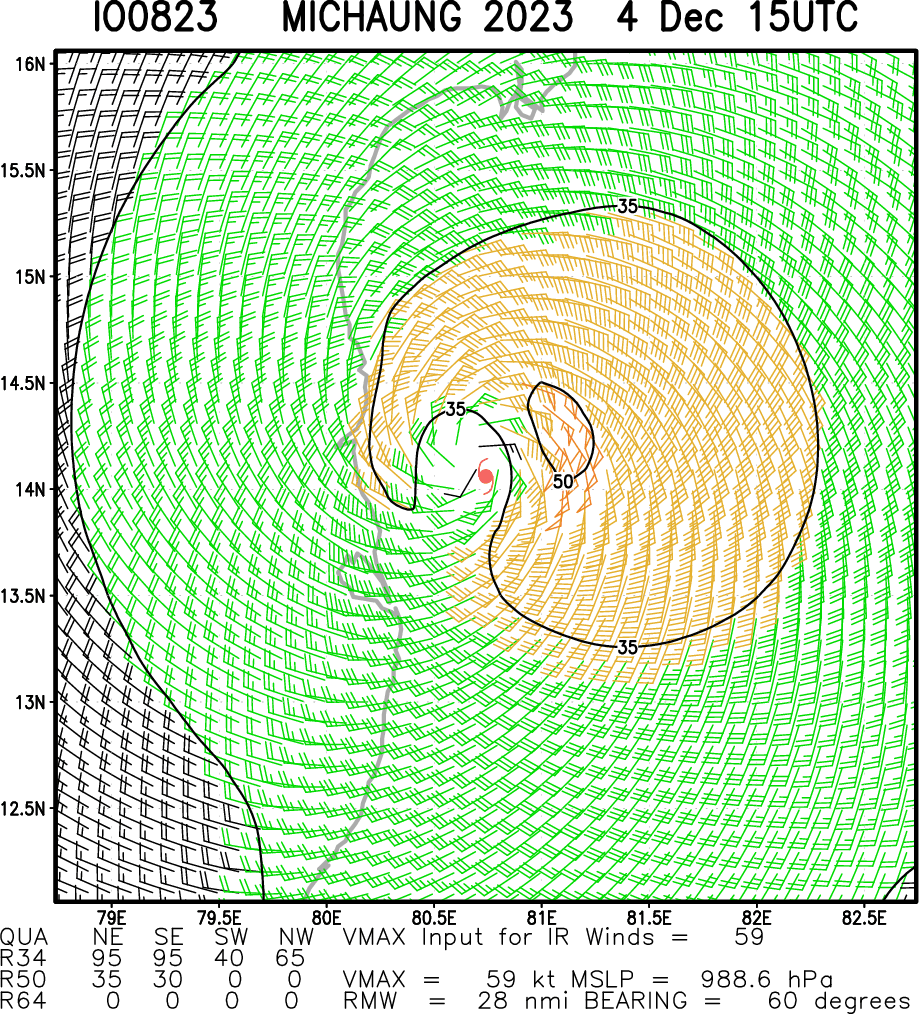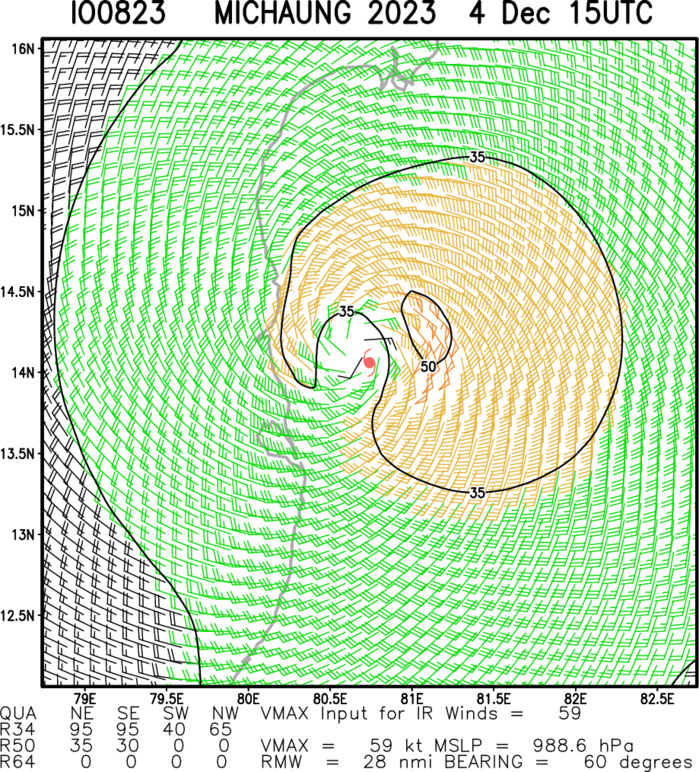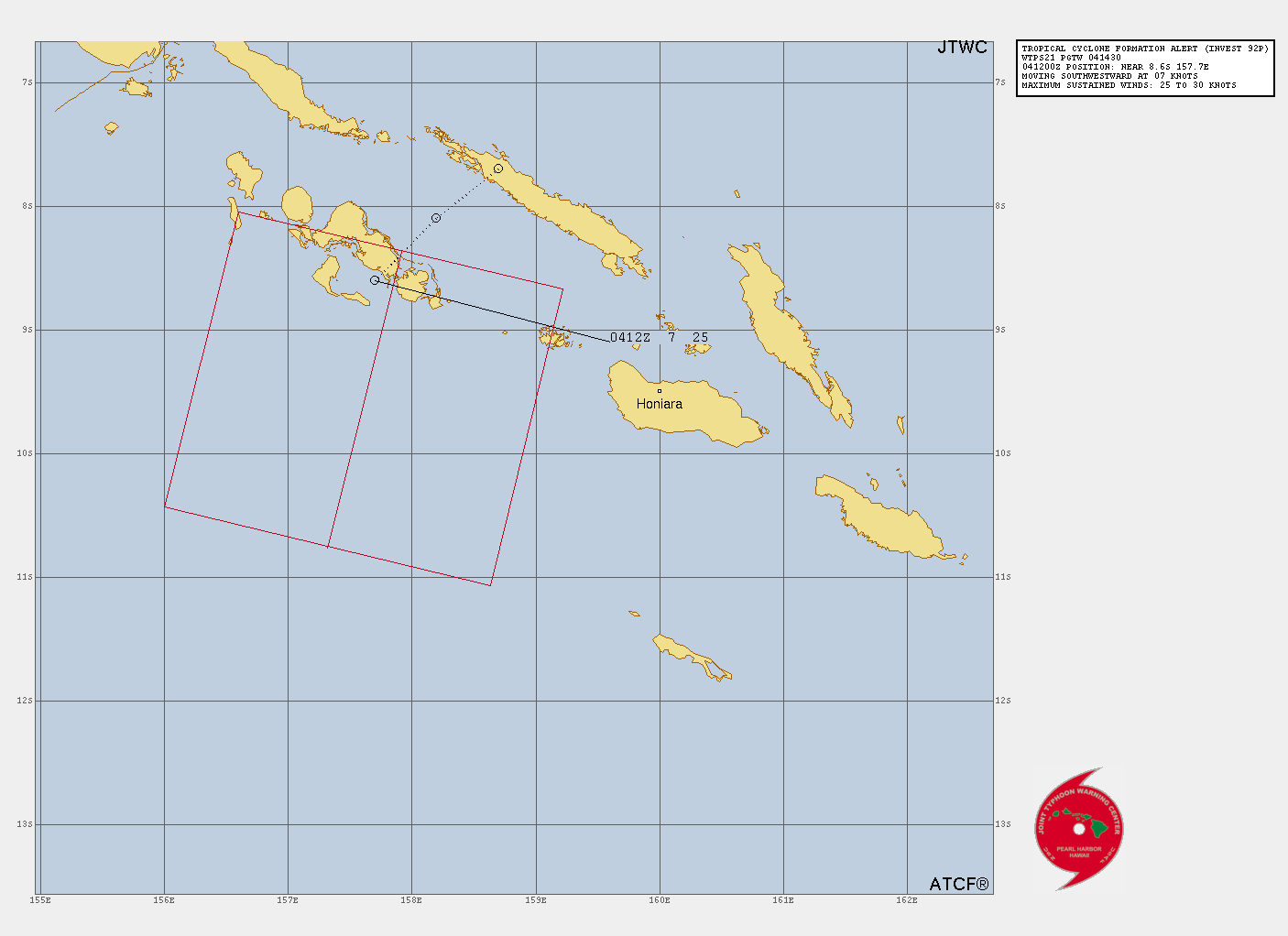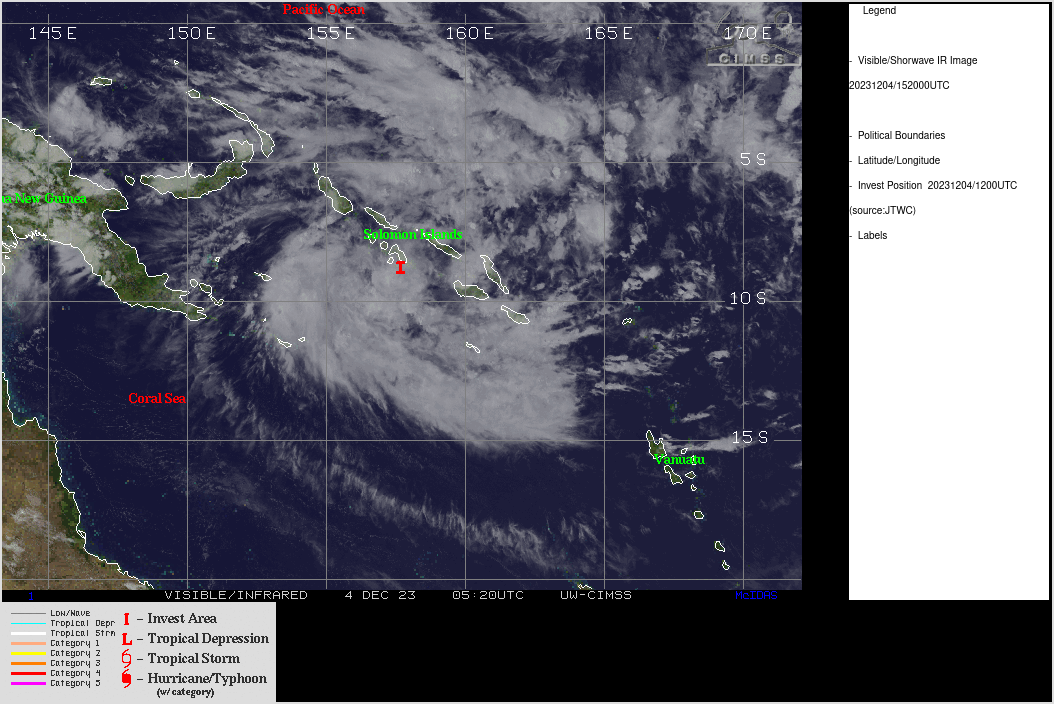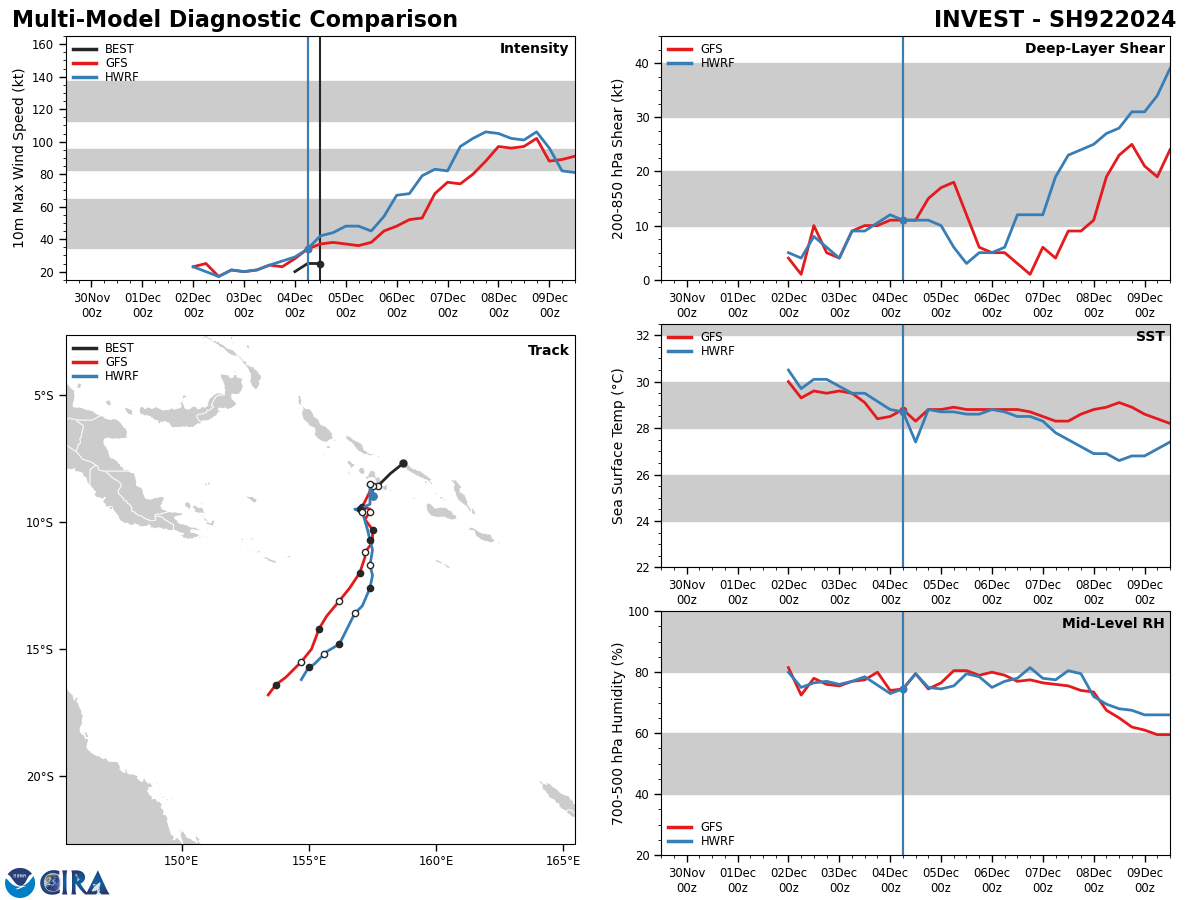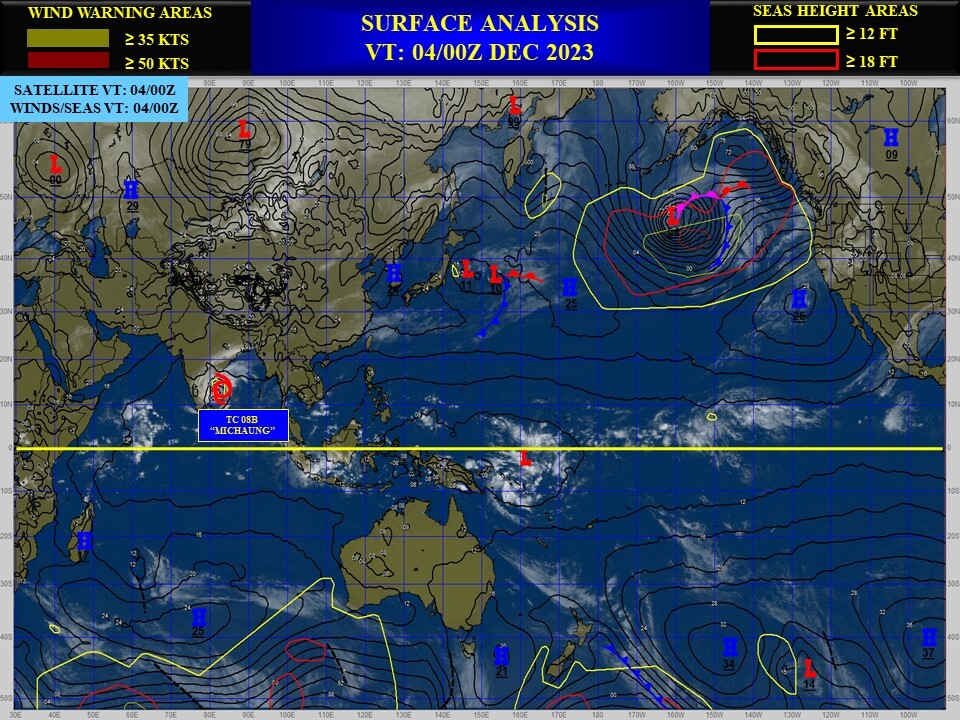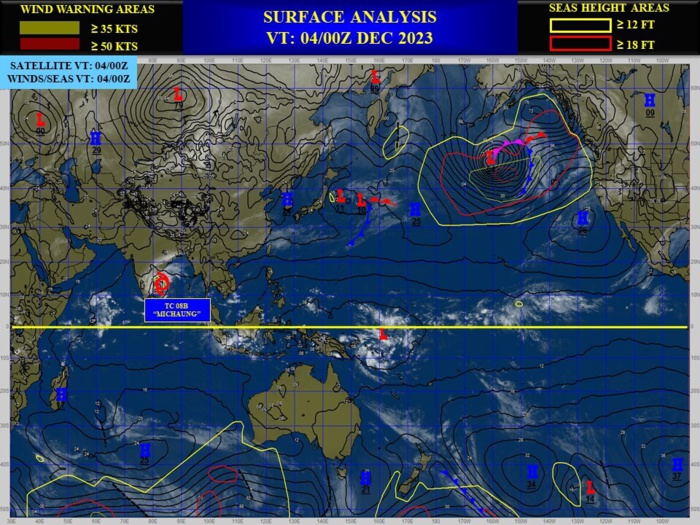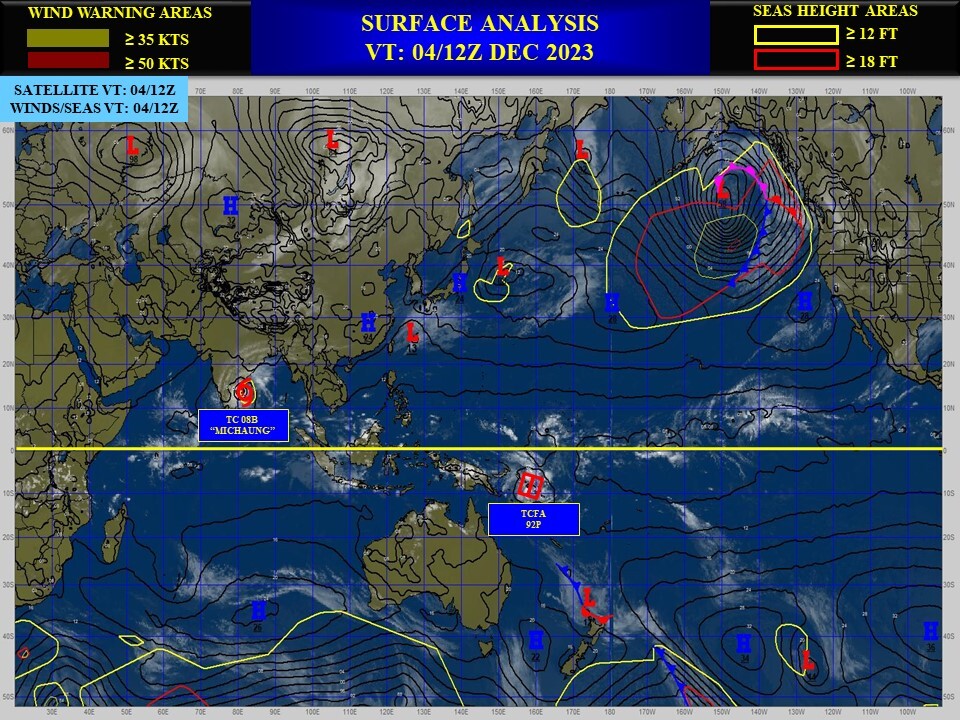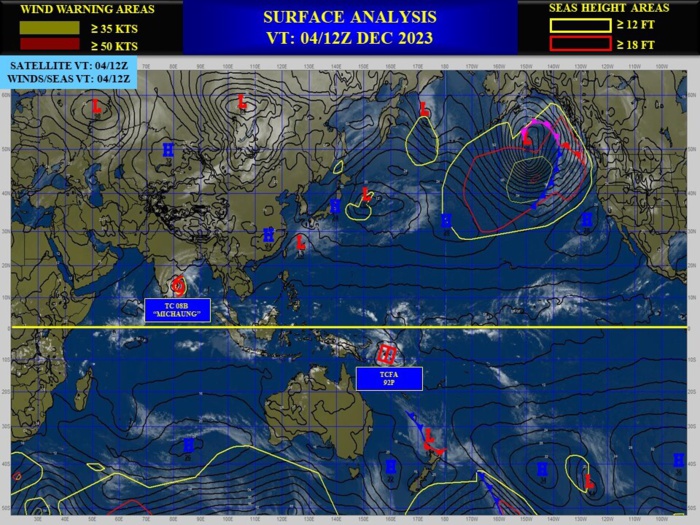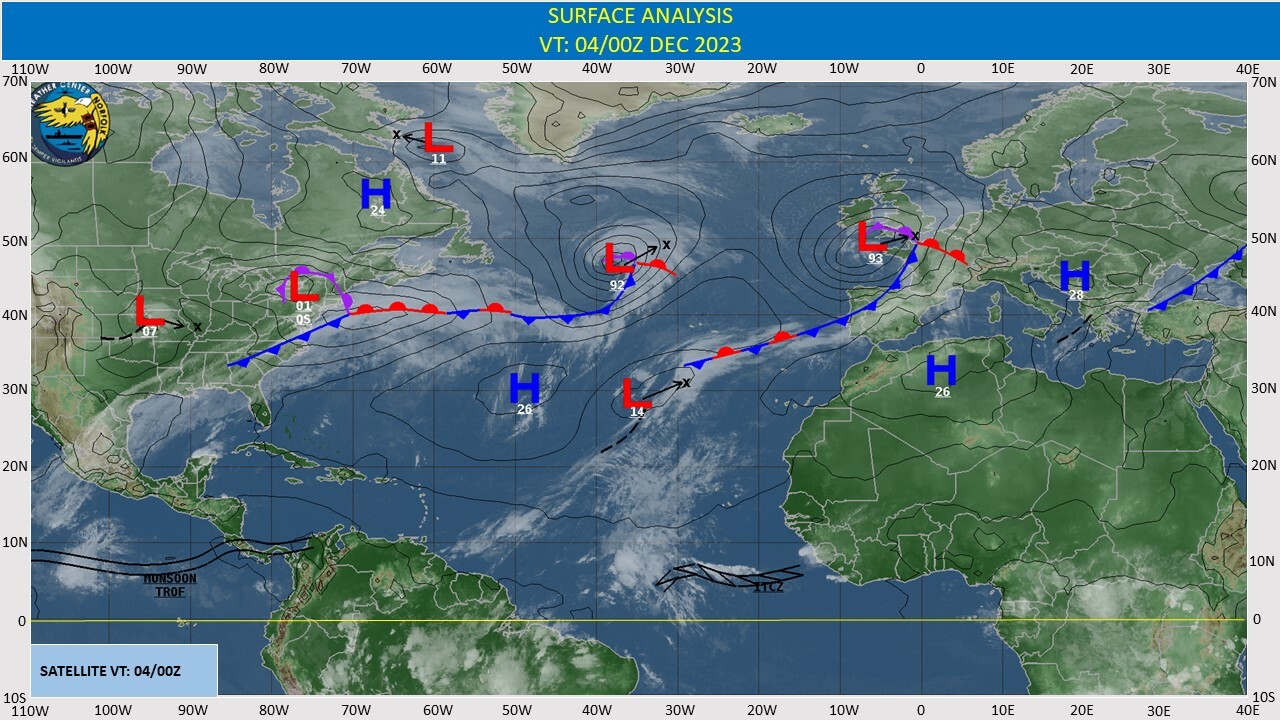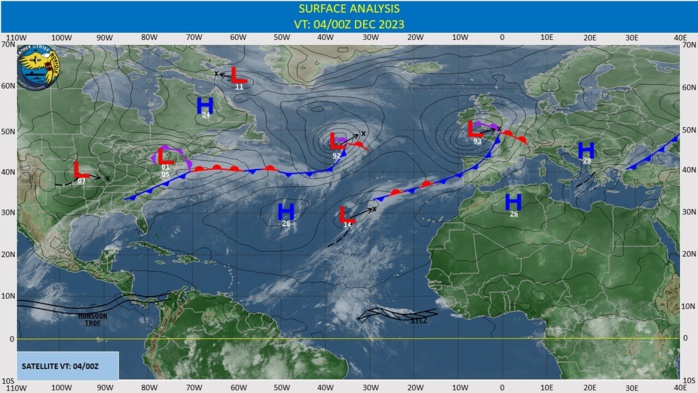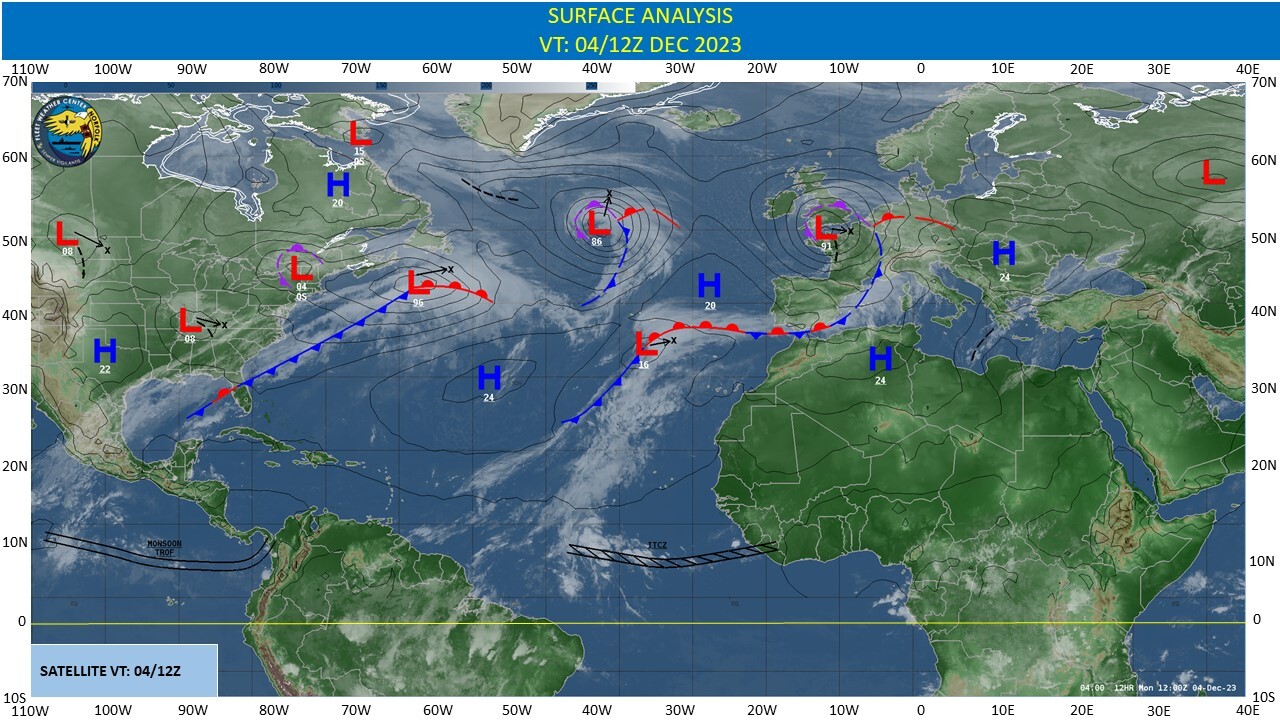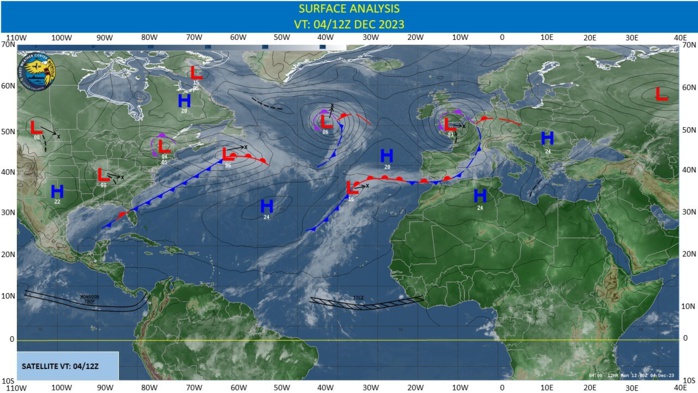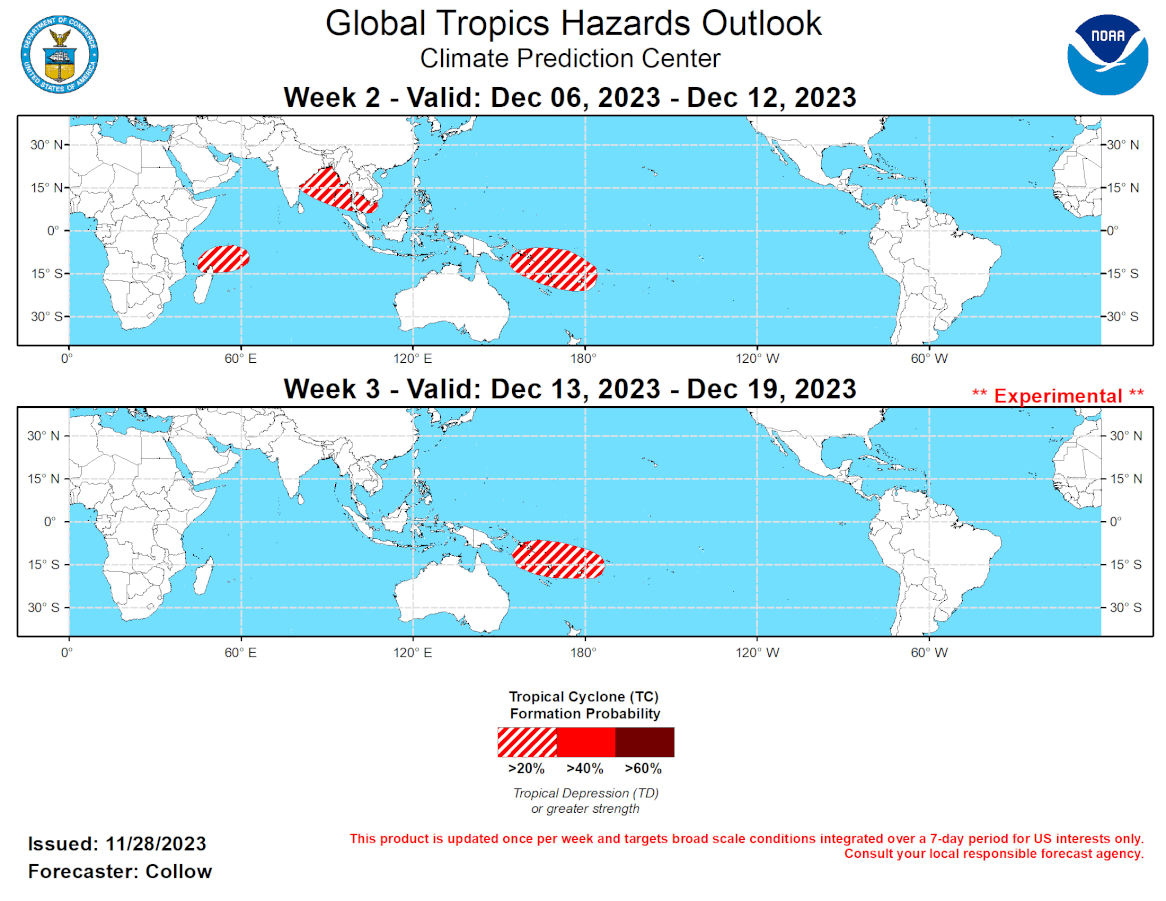CLICK ON THE IMAGERIES BELOW TO GET THEM ENLARGED
NORTH INDIAN OCEAN/BAY OF BENGAL: TC 08B(MICHAUNG). CURRENT ESTIMATED INTENSITY IS 60 KNOTS: +20 KNOTS/24H.
0823113006 77N 880E 20
0823113012 82N 872E 20
0823113018 87N 865E 20
0823120100 95N 862E 20
0823120106 99N 857E 20
0823120112 101N 852E 25
0823120118 102N 848E 25
0823120200 104N 843E 25
0823120206 106N 839E 25
0823120212 107N 834E 30
0823120218 108N 831E 30
0823120300 113N 829E 35
0823120306 119N 829E 35
0823120312 123N 824E 40
0823120318 127N 818E 45
0823120400 130N 814E 50
0823120406 134N 811E 55
0823120412 138N 808E 60
0823113012 82N 872E 20
0823113018 87N 865E 20
0823120100 95N 862E 20
0823120106 99N 857E 20
0823120112 101N 852E 25
0823120118 102N 848E 25
0823120200 104N 843E 25
0823120206 106N 839E 25
0823120212 107N 834E 30
0823120218 108N 831E 30
0823120300 113N 829E 35
0823120306 119N 829E 35
0823120312 123N 824E 40
0823120318 127N 818E 45
0823120400 130N 814E 50
0823120406 134N 811E 55
0823120412 138N 808E 60
WARNING 7 ISSUED AT 04/15UTC.
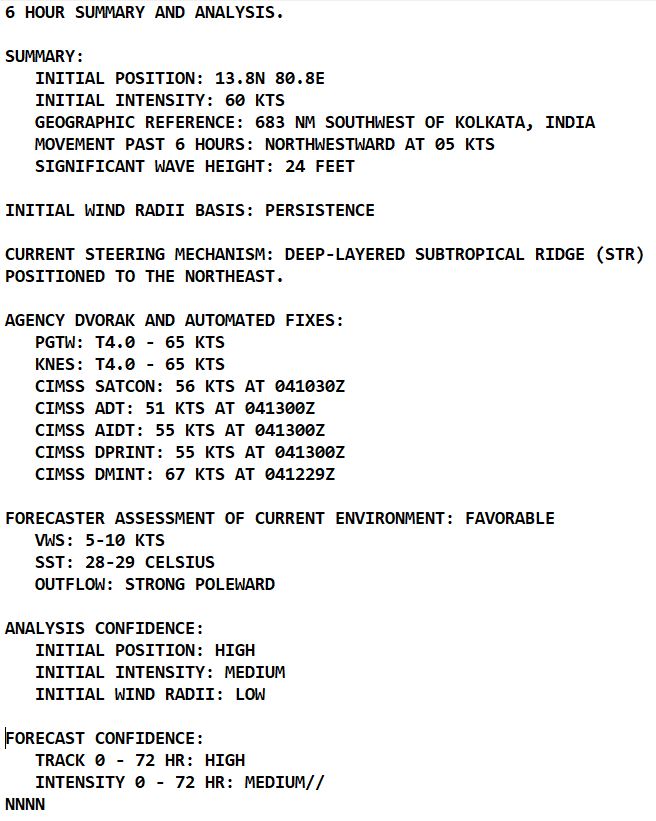
CLICK ON THE IMAGERY BELOW TO GET IT ANIMATED AND ENLARGED.
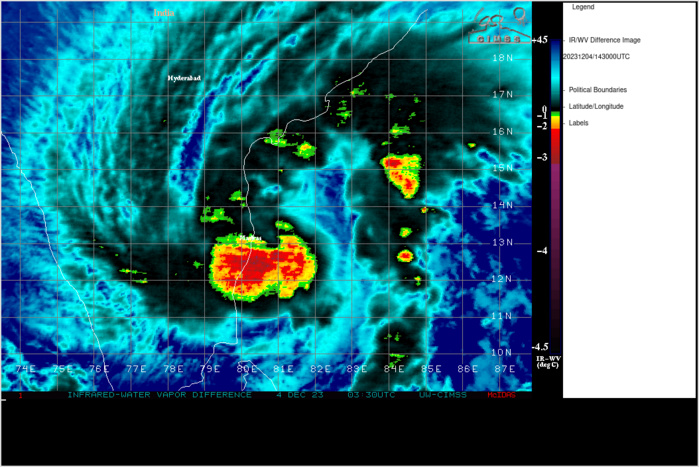
SATELLITE ANALYSIS, INITIAL POSITION AND INTENSITY DISCUSSION: AS DEPICTED IN ANIMATED ENHANCED INFRARED (EIR) SATELLITE IMAGERY AND RADAR IMAGERY, TROPICAL CYCLONE (TC) 08B HAS CONTINUED TO CONSOLIDATE WITH TIGHTLY-CURVED BANDING WRAPPING INTO A FORMATIVE RAGGED EYE. THEREFORE, THERE IS HIGH CONFIDENCE IN THE INITIAL POSITION. A 041226Z SSMIS 37 GHZ COLOR COMPOSITE MICROWAVE IMAGE REVEALS A CYAN RING SURROUNDING A WELL-DEFINED MICROWAVE EYE. CONSEQUENTLY, THE PGTW DVORAK INTENSITY ESTIMATE HAS INCREASED TO T4.0 (65 KNOTS). THE KNES FINAL-T ESTIMATE IS CURRENTLY AT T4.0 AS WELL (CURRENT INTENSITY IS AT 4.5 (77 KNOTS)). THE INITIAL INTENSITY IS ASSESSED SLIGHTLY LOWER THAN 65 KNOTS BASED ON THE CIMSS OBJECTIVE INTENSITY ESTIMATES RANGING FROM 51 KNOTS TO 67 KNOTS.
TC Warning Graphic
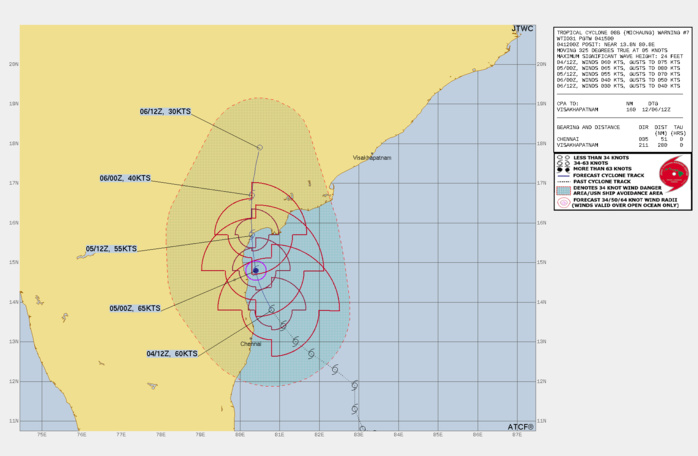
FORECAST REASONING. SIGNIFICANT FORECAST CHANGES: THERE ARE NO SIGNIFICANT CHANGES TO THE FORECAST FROM THE PREVIOUS WARNING. FORECAST DISCUSSION: TROPICAL CYCLONE (TC) 08B IS FORECAST TO TRACK POLEWARD ALONG THE WESTERN PERIPHERY OF A NORTH-SOUTH ORIENTED STR THROUGH TAU 48. THE SYSTEM SHOULD INTENSIFY SLIGHTLY OVER THE NEXT 12 HOURS DUE TO THE FAVORABLE ENVIRONMENTAL CONDITIONS, WITH A PEAK OF 65 KNOTS ANTICIPATED BY TAU 12. AFTER TAU 12, TC 08B WILL GRADUALLY WEAKEN AS IT SKIRTS THE EASTERN COAST OF INDIA WITH LANDFALL EXPECTED NEAR TAU 24. AFTER LANDFALL, THE SYSTEM WILL RAPIDLY WEAKEN AND DISSIPATE AS IT TRACKS INLAND AND RECURVES NORTHEASTWARD, INTERACTING WITH THE MIDLATITUDE WESTERLIES AND INCREASING VERTICAL WIND SHEAR. THE REMNANTS COULD POSSIBLY TRACK OVER THE NORTHERN BAY OF BENGAL AFTER DAY 4 BUT ARE NOT EXPECTED TO REGENERATE DUE TO UNFAVORABLE CONDITIONS AND STRONG UPPER-LEVEL WESTERLIES.
24H FORECAST TRACK
Model Diagnostic Plot
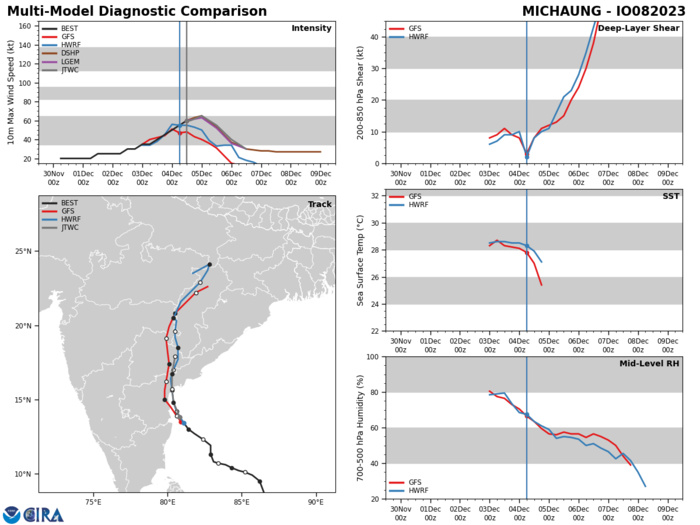
MODEL DISCUSSION: BOTH DETERMINISTIC AND PROBABILISTIC GUIDANCE ARE IN GOOD AGREEMENT THROUGH TAU 48. THERE IS CURRENTLY A 35 NM CROSS- TRACK SPREAD IN NUMERICAL GUIDANCE FROM TAU 12 TO TAU 24. AFTER TAU 24, GUIDANCE DIVERGES SLIGHTLY BUT REMAINS IN GOOD AGREEMENT. THEREFORE, THERE IS HIGH OVERALL CONFIDENCE IN THE JTWC TRACK FORECAST. THE JTWC INTENSITY FORECAST IS SUPPORTED BY RELIABLE INTENSITY GUIDANCE INCLUDING THE HAFS-A AND COAMPS-TC MESOSCALE MODEL GUIDANCE.
RIPA Forecast AND RIPA STORM TABLE ATTACHED BELOW
Multiplatform Satellite Surface Wind Analysis (Experimental)
SOUTHERN HEMISPHERE/SOUTH PACIFIC: INVEST 92P. TROPICAL CYCLONE FORMATION ALERT ISSUED AT 04/1430UTC.
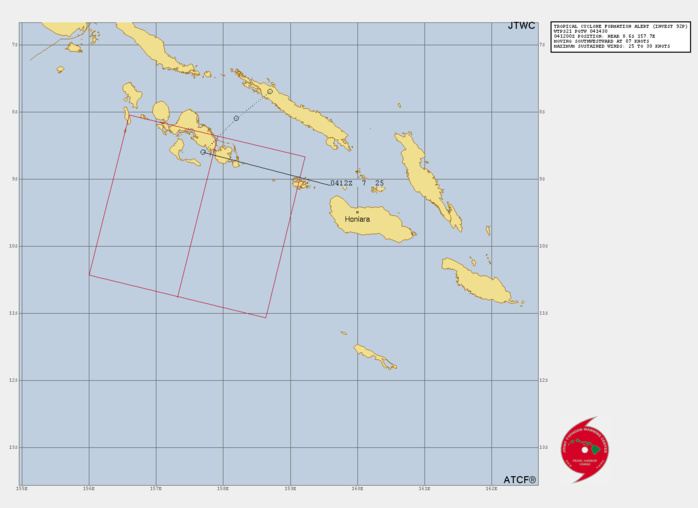
THE AREA OF CONVECTION (INVEST 92P) PREVIOUSLY LOCATED NEAR 8.7S 158.3E IS NOW LOCATED NEAR 8.6S 157.7E, APPROXIMATELY 147 NM WEST-NORTHWEST OF HONIARA, GUADALCANAL. ANIMATED ENHANCED INFRARED SATELLITE IMAGERY AND 041059Z MHS 89 GHZ MICROWAVE IMAGE DEPICT FRAGMENTED FORMATIVE BANDING BEGINNING TO WRAP INTO THE LOW-LEVEL CIRCULATION CENTER (LLCC). THE SYSTEM IS ALSO SHOWING IMPROVED PERSISTENT DEEP CONVECTION OVER THE CENTER. ENVIRONMENTAL ANALYSIS INDICATES THAT 92P IS IN A MARGINALLY FAVORABLE ENVIRONMENT FOR DEVELOPMENT WITH EXCEPTIONAL POLEWARD OUTFLOW ALOFT AND WARM (29C) SEA SURFACE TEMPERATURES OFFSET BY MODERATE TO HIGH (20-30 KTS) VERTICAL WIND SHEAR. GLOBAL MODELS ARE IN GOOD AGREEMENT THAT 92P WILL TRACK SOUTHWARD INTO THE CORAL SEA AS IT CONTINUES TO DEVELOP OVER THE NEXT 24-48 HOURS. MAXIMUM SUSTAINED SURFACE WINDS ARE ESTIMATED AT 25 TO 30 KNOTS. MINIMUM SEA LEVEL PRESSURE IS ESTIMATED TO BE NEAR 1000 MB. THE POTENTIAL FOR THE DEVELOPMENT OF A SIGNIFICANT TROPICAL CYCLONE WITHIN THE NEXT 24 HOURS IS UPGRADED TO HIGH.
9223120400 77S1587E 20
9223120406 81S1582E 25
9223120412 86S1577E 25
9223120406 81S1582E 25
9223120412 86S1577E 25
CLICK ON THE IMAGERY BELOW TO GET IT ANIMATED AND ENLARGED.
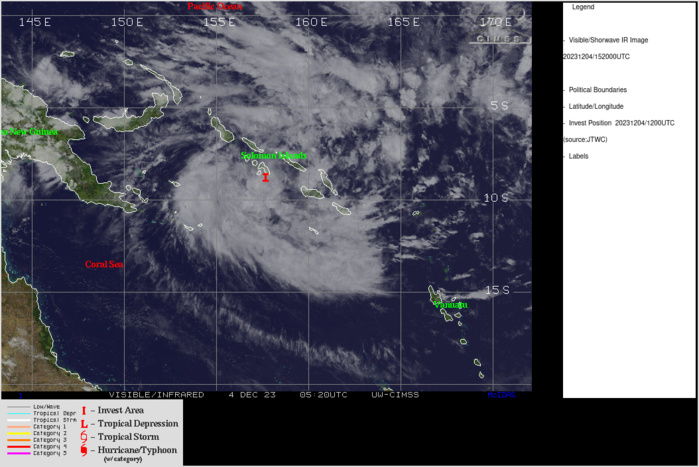
ANIMATED ENHANCED INFRARED SATELLITE IMAGERY AND 041059Z MHS 89 GHZ MICROWAVE IMAGE DEPICT FRAGMENTED FORMATIVE BANDING BEGINNING TO WRAP INTO THE LOW-LEVEL CIRCULATION CENTER (LLCC). THE SYSTEM IS ALSO SHOWING IMPROVED PERSISTENT DEEP CONVECTION OVER THE CENTER.
Model Diagnostic Plot
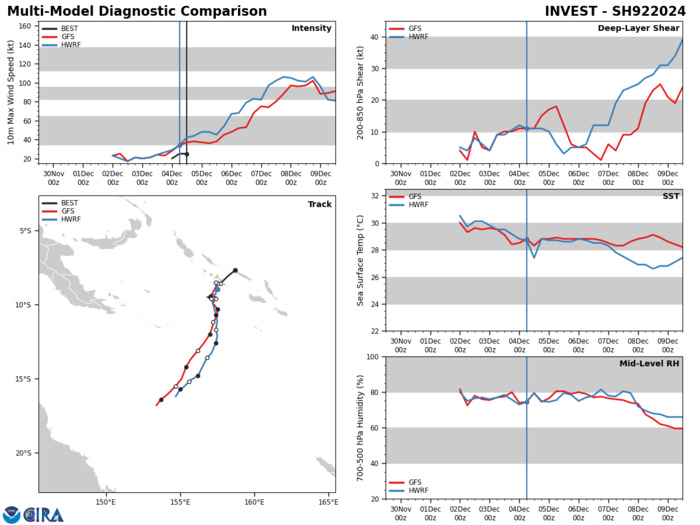
GLOBAL MODELS ARE IN GOOD AGREEMENT THAT 92P WILL TRACK SOUTHWARD INTO THE CORAL SEA AS IT CONTINUES TO DEVELOP OVER THE NEXT 24-48 HOURS.
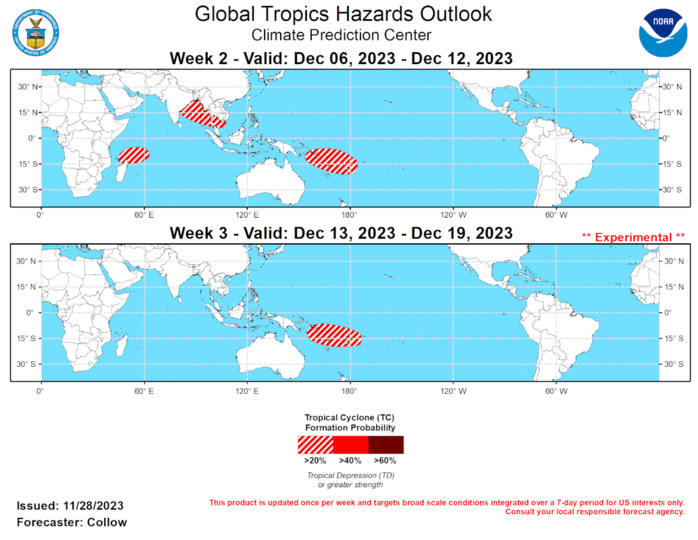
Last Updated - 11/28/23 Valid - 12/06/23 - 12/19/23 The RMM-based MJO signal continues to remain amplified and has propagated eastward into the Indian Ocean during the past week. A wave-1 asymmetry pattern is depicted in the spatial upper-level velocity potential anomalies with upper-level divergence (convergence) indicated across Africa and the Indian Ocean (Western Hemisphere), a pattern consistent with the MJO and the ongoing positive phase of the Indian Ocean Dipole (+IOD). Although destructive interference with the low frequency El Nino base state is favored in the near-term, both the GEFS and ECMWF ensembles are in good agreement regarding continued eastward propagation of the intraseasonal signal into the Pacific during the next 2 weeks, which favors more constructive interference with El Nino, and a return to a convective pattern more resembling the low frequency base state by mid-December. The only tropical cyclone (TC) formation during the past week was Tropical Storm Ramon in the East Pacific on 11/23, which was a weak system with no impacts to land. Elsewhere, the global tropics have been quiet, although activity may begin to increase across the Indian Ocean given the favorable convective environment aloft. Invest 99W may develop into a tropical cyclone over the Bay of Bengal during the next few days, and this area could remain active into week-2, where a 20 percent chance of TC development is highlighted. The +IOD favors increased moisture over the western Indian Ocean, and it is plausible that a TC could spin up during the week-2 period, supporting a 20 percent chance of TC formation around the northern tip of Madagascar and extending eastward to around 60 deg E. Consistent with the predicted MJO evolution, the main convective envelope is forecast to shift eastward later in week-2 and into week-3, and this could increase TC development chances across the southwestern Pacific during the first half of December. TC track probabilities are elevated in the GEFS and ECMWF ensembles across the Coral Sea and near the Solomon Islands and Vanuatu, and a 20 percent chance of TC development is highlighted over these areas for weeks 2 and 3. The return to a convective pattern more typical of El Nino favors TC genesis chances shifting more eastward, tied to the continued propagation of the enhanced convective envelope into the Central Pacific, as well as increasing constructive interference with the reemerging low frequency base state. While the convective environment may also become more favorable across the western North Pacific during the next 2-3 weeks, no TC risk areas were designated given today’s dynamical guidance generally depicting elevated chances of TC development in the Southern Hemisphere, and is more consistent with climatology going into December.
